So yesterday I had the chance to check out the R7 370, AMD’s current budget video card. Well today Nvidia is officially announcing and releasing the GTX 950. The GTX 950 falls in between the GTX 960 and the GTX 750 Ti. This fills in a gap in the Nvidia lineup and should compete directly with the R7 370. Like I mentioned yesterday, this isn’t a price point that enthusiasts who are building high end PCs would be looking at but it does fall right into the sweet spot for budget gaming builds around the $600 price point. So with that in mind today we are going to see what the GTX 950 is all about, find out how it fits in between the 960 and 750 Ti in both performance and specifications, then find out if it is the right option for people looking at building their new $600 gaming PCs.
Product Name: Asus GTX 950 Strix
Review Sample Provided by: Nvidia
Written by: Wes
Pictures by: Wes
Amazon Link: HERE
| Specifications | |
| Model name | STRIX-GTX950-DC2OC-2GD5-GAMING |
| Graphics Engine | NVIDIA® GeForce® GTX 950 |
| Bus Standard | PCI Express® 3.0 |
| OpenGL | OpenGL® 4.5 |
| Video Memory | 2GB GDDR5 |
| GPU boost clock |
OC Mode : 1355 MHz Gaming Mode: 1329 MHz |
| GPU base clock |
OC Mode : 1165 MHz Gaming Mode: 1140 MHz |
| CUDA cores | 768 |
| Memory Clock | 6610 MHz |
| Memory Interface | 128 bit |
| DVI Output |
1x Native DVI-I 1x Native DVI-D |
| HDMI Output | 1x Native HDMI 2.0 |
| HDCP compliant | YES |
| DisplayPort | 1x Native DisplayPort 1.2 |
| Accessory Bundled | 1x STRIX Laser Sticker |
| Software Bundled | ASUS GPU Tweak II & Driver |
| Dimension |
22x12.5x4 cm 8.7x4.9x1.6 inches |
Nvidia GTX 950
Before I dig into the GTX 950 Strix and get into testing I did want to talk a little about the GTX 950 itself. Specifically I wanted to talk about where it falls in the Nvidia lineup. It might be obvious given the name but the GTX 950 does fall in right behind the GTX 960. What gets a little weird is the card below the GTX 950 is the GTX 750 Ti. Rather than introducing a rebranded card Nvidia has just left the GTX 750 Ti in the product stack, we can assume they will replace it in the future but currently they have nothing announced there. So here is the current product stack and price list.
GTX TITAN X: $999
GTX 980 Ti: $649
GTX 980: $499
GTX 970: $329
GTX 960: $199
GTX 950: $159
GTX 750 Ti: $119
The GTx 950 falls right into a nice sweet spot when you consider the price point as well. The GTX 960 is on the high end of budget builds at $199, the GTX 950 is a little better priced and right at what you will be spending for a $500 to $600 gaming build. Then we have the GTX 750 Ti bringing up the rear at the $119 price point.
So beyond the price how does it compare to the GTX 960 and GTX 750 Ti? Well officially it is actually based on the same GM206 Maxwell GPu that the GTX 960 has. They did cut it down slightly from 1024 CUDA cores down to 768. The clock speed is a little unque, the core clock speed is lower than the GTX 960 but the boost clock speed is a little higher. The memory is slowed down slightly as well. These changes allow for less power usage lowering the TDp from 120 Watts to 90 Watts. A lot of people hated on the 128 bit memory controller that the GTX 960 has and the GTX 950 has that same controller and same 2GBs of memory. At the GTX 950’s launch price point its direct competition is the R7 370 and it does have a higher memory bus width and more memory. We will have to see in testing how they actually compare in performance though. Below I have included a full breakdown between the GTX 950 and the GTX 750 Ti/GTX 960.
| GTX 950 | GTX 960 | GTX 750 Ti | |
| CUDA Cores | 768 | 1024 | 640 |
| Texture Units | 48 | 64 | 40 |
| ROPs | 32 | 32 | 16 |
| Core Clock | 1024 MHz | 1126MHz | 1020 MHz |
| Boost Clock | 1188 MHz | 1178MHz | 1085 MHZ |
| Memory Clock | 6600 MHz | 7000 MHz | 5400 MHz |
| Memory Bus Width | 128-bit | 128-bit | 128-bit |
| VRAM | 2GB | 2GB | 1GB or 2GB |
| TDP | 90W | 120W | 60W |
| GPU | GM206 | GM206 | GM107 |
| Transistor Count | 2.94 Billion | 2.94 Billion | 1.87 Billion |
| Launch Price | $159 | $199 | $149 |
Beyond the GTX 950 Nvidia did introduce a few other new features with this launch. One a driver and software feature and the other was software only. The driver and software change was the result of Nvidia taking a hard look at one of the most popular game types, MOBAs. While I would argue that these changes are just as important on any competitive game, on our call with Nvidia they spoke a lot about how important response time is when playing DOTA 2 and LoL. Internally they did a lot of testing on the amount of time it takes for your game to render and show a mouse click. They setup a way to record when the mouse button was actually hit and measured how long it would be before it shows on screen. For the GTX 650 that they compared to they were seeing 80ms response times. Here is a video of their testing.

Now keep in mind they used the GTX 650 as this is the card they expect GTX 950 users to be upgrading from. On top of card performance improvements they went deeper into the issue and found that they could further improve the response time by cutting out some of the frame preloading. They preload to improve performance, but in this case it adds the response latency. So now with GeForce Experience they can set a maximum pre-rendered frames. The way they explained it is that currently people with the GTX 950 will see it automatically assuming they let GeForce Experience set their game settings. People running other cards will see it later as they finish more testing with those confirmations or you can manually go in and set it as well. You can do this in the manage 3D Settings page in Nvidia Control Panel.
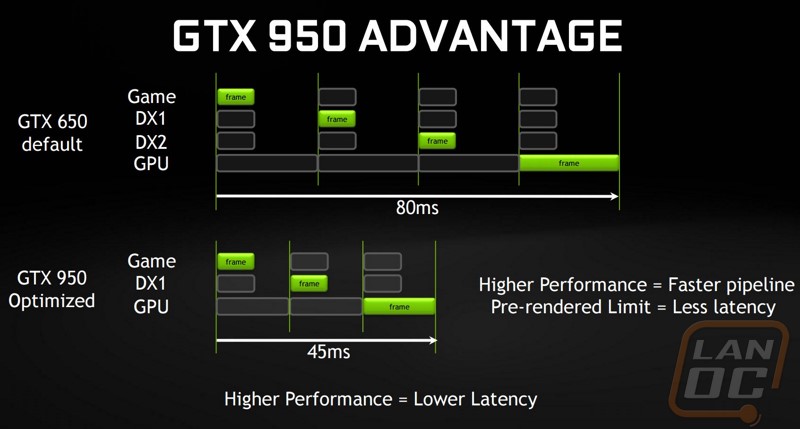
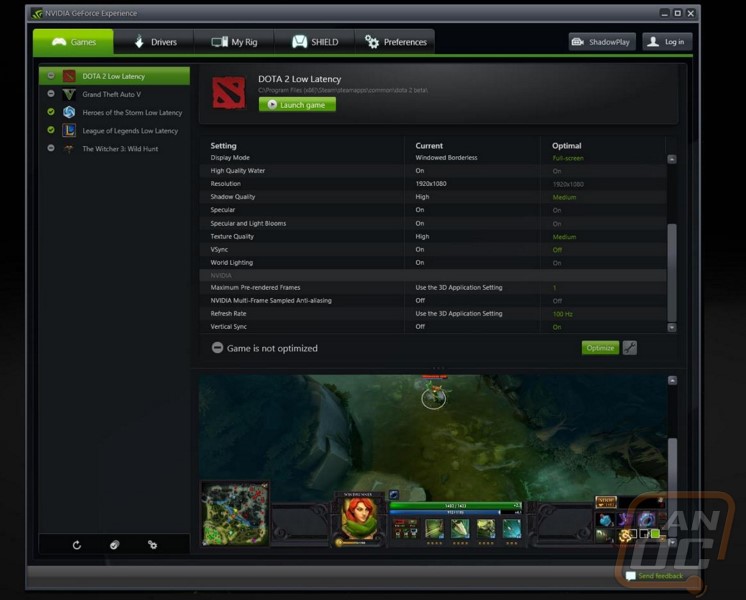
The big software change isn’t live yet but is coming very soon. Some of you might be familiar with ShadowPlay, I know I have used it for streaming a few times and more than anything have used it to play games on my Shield devices. Well Nvidia is dropping the ShadowPlay name and adding new features. The features they currently have are staying but you can now open up a gallery and view images and videos you have recorded. Once you do that you can select a video you want to upload directly to YouTube and you can cut the video down and upload it all within the software.

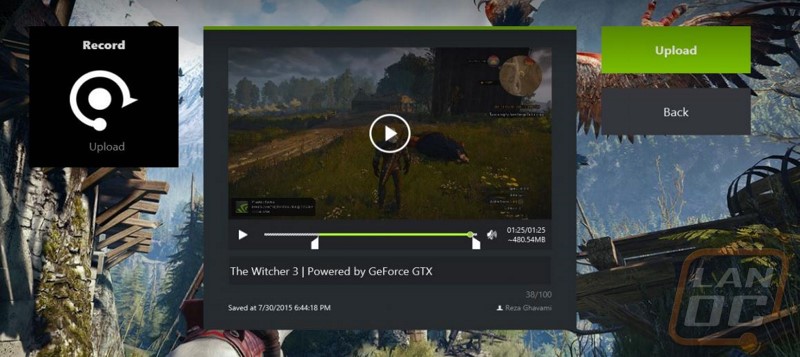
The biggest addition is really just an extension on the on network streaming that the Shield devices have been doing, but it is still a huge feature in my opinion. Basically you can send an invite to any friend and invite them to join your game via a chrome browser extension. So it’s like twitch then right? Well not really, that person can watch you play the game live, you can mirror your controls and let them take over your game, or in games that support it you can actually play Co-Op together. They include integrated voice chat as well for communication. The examples Nvidia showed for this new features use were latency free 1:1 broadcasts, allowing your friends to demo new games, playing together in Co-Op, and helping your buddy beat a level. That last feature might be a little taboo for some people, while it isn’t anything crazy to have your brother or friend help you with a level you are stuck on when playing on a console, it isn’t something you see on PC gaming all that much. Even beyond that some games like League or Legends actually will ban people who have people (friends or otherwise) play on your account to boost your ranking. Nvidia did set a one hour limit on this new feature, I’m not sure what the reason for that was exactly but that might prevent people basically letting a friend play all the way through a game without buying it.
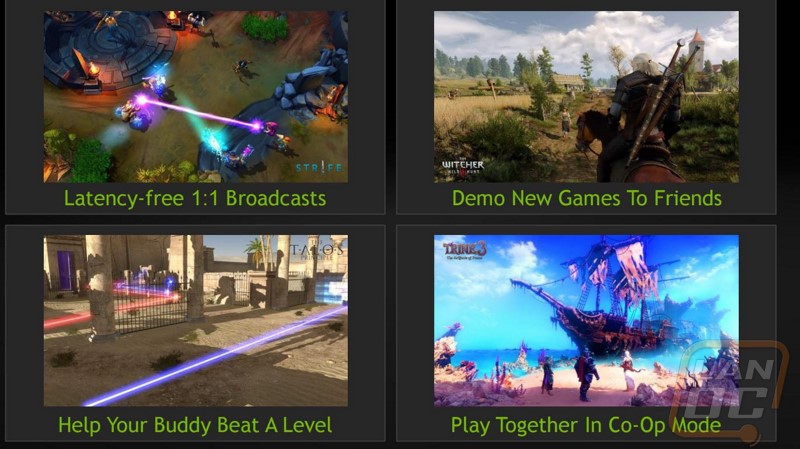
For me this feature interests me in a way that they don’t seem to be pushing just yet. One of the best things about the various Shield devices is being able to play your PC games on your mobile device or in the other room. I can see this feature being a sneaky way to log into your home PC and play games while on PCs that don’t have the power to game like at work or on your laptop. All in all I’m happy to see that Nvidia continues to develop their software to add more features for everyone. I’m sure it is a big financial investment for them but it adds a lot to the overall experience of suing an Nvidia card in your build.
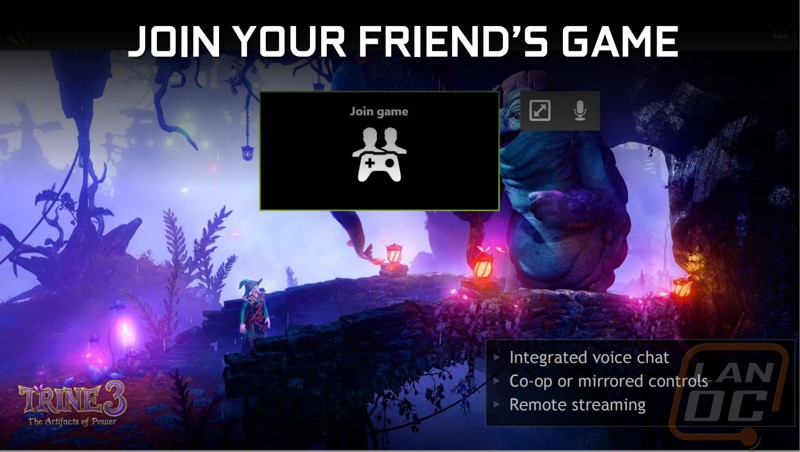

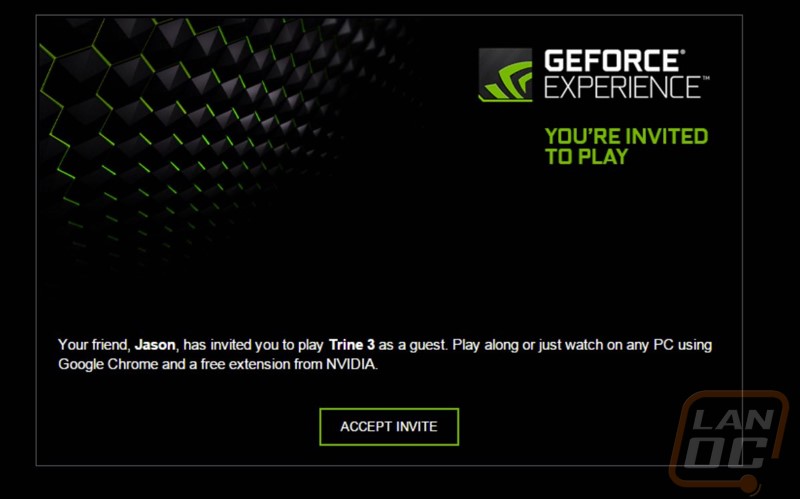
Packaging
The GTX 950 that Nvidia sent over wasn’t a reference card, they went right with an overclocked Asus card, specifically the GTX 950 Strix. Because of that we get a chance to take a quick look at the packaging before digging into the card. The front of the box has a much more defined robotic owl in the background than in the past. The cover has the standard Nvidia naming on the bottom right and then the Asus and Strix logos are up above. They slipped in a comment about the cooler performing 20% cooler and silent gaming. There are also a few features listed below the Nvidia section noting that the card works with Windows 10 and supports G-Sync for example. The back of the box has a lot more going on. Here Asus has split up a few of the cards key features and highlighted them with a photo and a short explanation of what they are all about. They highlight the DirectCU II cooler, 0dB Fan, super allow power II, and even their GPU Tweak software. Down on the bottom we actually see a photo of the card as well as a line drawing of the display connection options. There is a small specification list as well but there isn’t anything useful in it like the card dimensions for example.


Inside the box the card is wrapped in a static protective bag and it sits in a formed cardboard section. Up under the card you get a driver/software disk a “Speed Setup” guide, and a multi-color Strix logo sticker. They didn’t include any power adapter cables, something I normally expect to see with a card like this to help people who don’t have a 6-pin power connection.


Card Layout and Photos
I spoke about the GTX 950 in detail earlier so before we get into the Strix’s design and photos I wanted to mention that on the hardware side of things Asus did overclock the Strix a little over the reference GTX 950 design. The reference design has a core clock of 1024 MHz and the Strix has a base clock of 1140 MHz or 1165 MHz depending on if you are running the OC mode or Gaming mode. The reference boost clock comes in at 1188MHz where the Strix hits 1355 MHz in the OC Mode and 1329 MHz in the Gaming Mode. We still get the same 2GB GDDR5 running through a 128 bit interface. The memory clock speed is 6610MHz where the reference design is listed at 6600MHz.
Where the Strix really stands out compared to a reference card is the Strix version of the DirectCU II cooler. When you look at the image below you can see the Strix Owl eyes for the fans and the fan shroud helps define the face. The overall design is blacked out with red on the eyes and around the “nose” area. The fans used are a little smaller than what I have been seeing on a lot of the other coolers recently, I don’t know if this was to design decision to keep the owl look but one benefit is the overall design is relatively short. Of course the two large heatpipes on the top nearly take away all of the height benefits though.

The heatsink runs around 75% of the length of the card with a little room on the right side and a lot of room on the PCI side. The heatsink design uses a direct heatpipe contact design that we can see very well from the bottom of the card. The two heatpipes are very thick and pull the heat out to the ends of the heatsink. The two fans then push air down through the heatsink and against the PCB. The fan shroud design leaves an inch of space on all four sides for the air to vent into your case after it goes through the heatsink. This does mean you need to keep that in mind and make sure your case will vent the heat in small form factor builds.



For power the 950 Strix has a single six pin power connection to help power the 950’s 90 watt TDP. Asus flipped the connection backwards and notched the PCB to fit the clip. Flipping the plug allows them to get the heatsink and fan shroud closer without having to worry about people needing to get their fingers into the tight space.

For those who might look at increasing performance later the GTX 950 does come with one SLI bridge connection that will let you run two cards in SLI. Keep an eye on the website in the near future as we have already completed SLI testing and will be posting up the results.

The back of the card gives us a better look at the black PCB that runs the length of the card. We can also see the notched area on the PCB that gives us better access to the power connection up top and the metal support bracket across the top that helps secure the heatsink to the card.

For display connections the 950 Strix bucks the DisplayPort trend that I have been seeing where most cards have 3-4 DisplayPort connections. In place of that you get one DisplayPort, one HDMI, and then two DVI ports. This is a much better option given the cards price point. Even a lot of the people buying high end cards are still running DVI and HDMI monitors and for budget PCs it will be a long time before people are replacing their perfectly good 1080p DVI/HDMI monitors and going with 1440/4k monitors that use DisplayPort. The back slot also has a little additional ventilation on both sides of the second DVI port but given the open area right behind the PCI slot I doubt much air will be going out them.

Our Test Rig and Procedures
| Our Test Rig | ||
| CPU | Intel i7-3960X | Live Pricing |
| Memory | Corsair Vengeance 1600 MHz DDR3 RAM Quad Channel (4x4GB) | Live Pricing |
| Motherboard | Asus Rampage IV X79 Motherboard | Live Pricing |
| Cooling | Intel Active Thermal Solution RTS2011LC | Live Pricing |
| Power Supply | Cooler Master Gold Series 1200 Watt PSU | Live Pricing |
| Storage | Kingston Hyper X 3K 240GB SSD | Live Pricing |
| Case | High Speed PC Test Bench | Live Pricing |
| Our Testing Procedures | |
| 3DMark | The same goes for the most current version of 3DMark using the Fire Strike benchmark in normal, extreme, and ultra settings |
| Unigine Heaven Benchmark 4.0 | Using the “Extreme” preset |
| Unigine Valley Benchmark 1.0 | Using the Extreme HD preset to get an average FPS |
| Bioshock Infinite | Using the Adrenaline Action Benchmark Tool we run Bioshock Infinite on the “Xtreme” quality setting. This has a resolution of 1920x1080, FXAA turned on, Ultra Texture detail, 16x Aniso Texture Filtering, Ultra Dynamic Shadows, Normal Postprocessing, Light Shafts on, Ambient Occlusion set to ultra, and the Level of Detail set to Ultra as well. We also run this same test at 2560x1440 using the same settings as mentioned above. |
| Tomb Raider | Using the Adrenaline Action Benchmark Tool we run Tomb Raider on the “Xtreme” quality setting. This has a resolution of 1920x1080, Exclusive Fullscreen turned on, Anti-Aliasing set to 2xSSAA, Texture Quality set to Ultra, Texture Aniso set to 16x Aniso, Hair Quality set to TressFX, Shadow set to Normal, Shadow Resolution on High, Ultra SSAO, Ultra Depth of Field, High Reflection quality, Ultra LOD scale, Post Processing On, High Precision RT turned on, and Tessellation is also turned on. We also run this same test at 2560x1440 using the same settings as mentioned above. |
| Hitman: Absolution | Using the Adrenaline Action Benchmark Tool we run Hitman: Absolution on the “Xtreme” quality setting other than the MSAA setting is turned down from 8x to 2x. That setting puts the resolution at 1920x1080, MSAA is set to 2x, Texture Quality is set to High, Texture Aniso is set to 16x, Shadows are on Ultra, SSA is set to high, Global Illumination is turned on, Reflections are set to High, FXAA is on, Level of Detail is set to Ultra, Depth of Field is high, Tessellation is turned on, and Bloom is set to normal. We also run this same test at 2560x1440 using the same settings as mentioned above, except on the “high” setting. |
| Sleeping Dogs | Using the Adrenaline Action Benchmark Tool we run Sleeping Dogs on the “Xtreme” quality setting. That means our resolution is set to 1920x1080, Anti-Aliasing is set to Extreme, Texture Quality is set to High-Res, Shadow Quality is High, Shadow Filter is set to high, SSAO is set to High, Motion Blur Level is set to High, and World Density is set to Extreme. We also run this same test at 2560x1440 using the same settings as mentioned above. |
| F1 2014 | We use the built in benchmark for F1 2014. We use the Ultra setting and then test at 2560x1440 and 1920x1080 |
| Total War: ROME II | Ultra setting tested at 1920x1080 and 2560x1440, built in forest benchmark |
| Middle-earth: Shadow of Mordor | Using the built in benchmark we test with ultra settings at 1440p |
| Sniper Elite 3 | Ultra setting tested at 1920x1080 and 2560x1440, built in benchmark |
| GRID Autosport | Ultra setting tested at 1920x1080 and 2560x1440, built in benchmark |
| Theif | Tested using the “Very High” setting at 1920x1080 and 2560x1440 |
| Folding @ Home | Using the Folding @ Home benchmark we test both single and double precision using the explicit result |
| Cinebench R15 | OpenGL benchmark |
| Unreal Heaven Benchmark 4.0 heat testing | We run through Unreal Heaven using the “Extreme” preset for 30 minutes to test in game cooling performance. |
| Power Usage | Using Unreal Heaven Benchmark 4.0, we get our “load” power usage number from the peak power usage during our test. We get our numbers from a Kill-A-Watt connected to the test benches power cord. |
| Noise Testing | Our Noise testing is done using a decibel meter 3 inches away from the video card on the bottom/fan side of the card. We test an idle noise level and then to get an idea of how loud the card will get if it warms all the way up we also turn the fan speed up to 50% and 100% and test both speeds as well. The 100% test isn’t a representation of typical in game noise levels, but it will show you how loud a card can be if you run it at its highest setting or if it gets very hot. |
Synthetic Benchmarks
To start of my testing I ran the GTX 950 Strix through our synthetic benchmark suite. Here we can get a look at how the 950 compares to other cards, especially the R7 370. While synthetic benchmarks don’t show you how the card will perform in game, they are a consistent way to compare the performance gap from card to card at 1080p, 1440p, and 4k. In this card when testing in 3DMark using the performance setting the GTX 950 pulled a large lead on the R7 370 right out of the hole giving us numbers closer to the GTX 960 than I expected. When I turned up the settings higher the gap between the GTX 950 and the R7 370 did get smaller. In fact when we hit the ultra-setting the 370 actually pulled ahead. This actually makes a lot of sense though, the GTX 950 Strix has two gigs of video memory and that memory runs through a 128 bit memory interface. This isn’t an issue at 1080p but it chokes as we turn up the settings and the memory gets filled. While I would prefer the GTX 950 to have more memory and a bigger memory interface, the setup seems to be more than enough for 1080p gaming, what I would expect to be the goal for anyone buying the card. In the Heaven benchmark the 950 Strix fell right in between the R9 280 and the GTX 760 for performance, over 10 FPS higher than the R7 370. In the more demanding Valley benchmark the gap between the cards was smaller but still noticeable.



In-Game Benchmarks
So the synthetic benchmarks help pinpoint a possible issue where at higher resolutions the GTX 950 falls a little behind. Now it is time to see how well it performs in the real world in real games. To do that I tested using nine different modern games using a variety of game types and game engines. I did the testing at both 1080p and again at 1440p. The GTX 950 isn’t designed to perform at 1440p but I was still curious if it would play any of our games at their highest settings at that resolution. To help make things simpler with all of our video card reviews I like to break things down into three categories by their resolution. The first is under 30 FPS or what I consider to be unplayable, second is over 30 FPS and under 60 FPS aka playable but not perfect, and lastly everything over 60 FPS the ideal frame rate. To help I have actually put the results into two graphs, one for 1080p and the other 1440p.


So what are the end results? Well the short version is about what was expected, the GTX 950 Strix crushes 1080p but struggles with 1440p. At 1080p there is a good list of games that can be played with the settings cranked without any changes but the rest will take a few small changes to get up over the 60 FPS sweet spot if you prefer that. At 1440p I was surprised anything was playable, but three games were. That does leave a lot of games in the unplayable list but why are you trying to push 1440p with a card that costs half what your monitor does anyhow! Of course even with the new graphs I still wanted to include the full results as well, as a whole the 950 Strix out performed the 370 at 1080p consistently but at 1440p sometimes the 370 edged it out.









Compute benchmarks
Next I ran through a few compute benchmarks and learned a few things. For starters I was surprised at just how lose the GTX 950 was to the GTX 780 in the folding single precision benchmark. At double precision, just like at 1440p it fell completely on its face. That said in both it was still above the 370. In the Cinebench test that I only recently added I was surprised to see how much higher the GTX 950 performed when compared to the much faster R9 390’s. Clearly AMDs struggle here if Nvidia’s budget card is out performing like this.



Cooling, Noise, and Power
For my last set of testing I wanted to look at the cooling performance of the Strix’s DirectCU II cooling as well as the overall power usage. Both help separate a decent card with a great card when comparing GTX 950 to GTX 950. The first set of tests I ran was for power usage. Here I ran through Heaven Benchmark 4.0 and Valley Benchmark to see just how much our 6 core test bench with water cooling pulled at peak, this way we can see what king of power supply you will need to run the GTX 950 Strix. In Heaven Benchmark the 950 Strix pulled a reasonable 320 watts and in the more demanding Valley Benchmark it pulled 328. This is similar to the 326 that the R7 370 pulled in the same Valley Benchmark.


Next I tested the card at 100% fan speed, 50% fan speed, and at idle to see how much noise the cooler put out. This way I had a range of what it is capable of. At idle the Strix like every other modern card turned off the fans putting out no noise at all. Because of this I have dropped the idle results from our chart to make it easier to read. At 100% fan speed I was impressed that the Strix came in as one of the quietest cards tested. At 50% the noise was even lower. All in all you shouldn’t be worried about noise with this card, short of manually turning the fans up I doubt you will hear it at all.

For my last test I run through Valley Benchmark and let it run until the card reaches a temperature and stays at it. Here the 950 Strix leveled off at 69 degrees. This is in the middle of the pack because this is where most of today’s cards are programed to aim for temperature wise. This keeps the noise down as well by not turning the fans up until it is needed.

Overall and Final Verdict
So today we went over the GTX 950 and the new features that Nvidia is introducing to their drivers and software. Beyond that I went through and broke down the GTX 950 Strix and found out how well the new card performs. Going into this review I mentioned the new cards place in the market, at $159 for a standard GTX 950 it is direct competition to the R7 370 and just like the 370 it is right in the price sweet spot for being the ideal card for budget ($500-$600) builds. With that in mind, how did the card perform? Well first the overclocked Strix really impressed me in all of our synthetic and in game benchmarks when testing at or near 1080p. Given that is the resolution most people game at (especially people on a budget), that performance is very important. We did see the numbers drop down below the R7 370 when the resolution or textures went up higher than the 128 bit memory bus could handle though. In other words don’t expect to pick this card up and be playing anything and everything at 1440p or 4k, but at 1080p you should be able to toss anything you want at it.
Given the relatively low hardware demands that both league of Legends and DOTA 2 have this card is great for people who mostly focus on their MOBAs. This is why Nvidia spent time working on lowering the response time from when you click to when the click shows up on screen.
The Strix performed especially well in the noise testing as well. Obviously it runs completely silent under low loads because the fans don’t even turn on. But I was impressed with the numbers with the fan turned up just as much. The smaller fan size surely helps with that but Asus did also introduce a new fan blade design as well that helps keep things quiet and give good air flow.
Really the only issue with the GTX 950 and with that the GTX 950 Strix that I tested are the limitations on the memory side of things. But frankly if lower performance at a resolution that you wouldn’t be running on a card of this caliber is what you have to take to get great performance at 1080p I will take it. While the R7 370 that I tested yesterday performed well, the GTX 950 Strix did even better and it did it at a price point just under that of the overclocked R7 370 that I tested. The official MSRP of the R7 370 is still $10 less than the GTX 950, but having seen the performance numbers between the two I’m curious if they won’t take the price down slightly or maybe introduce a proper R7 370X to fill in the gap.
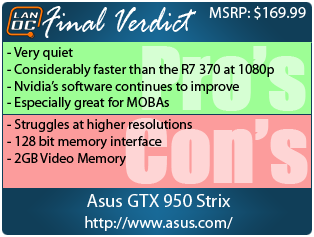

Live Pricing: HERE




